There is renewed interest in producing foods as a sideline income or for a living. Food businesses can find support in the growing consumer interest in local foods. Knowing what is required to sell cut and packaged produce can be confusing. This document is a brief guide that outlines the resources and topics that should be considered to produce and sell refrigerated fruits and vegetables in Nevada.
Introduction
Value-adding fruits and vegetables into high-quality food products is becoming a viable business option for Nevada farmers and food entrepreneurs. Nevada farmers face challenges for use of produce that is high quality but not premium enough for fresh sales because of visual blemishes or being too ripe to get to market without acquiring damage. Cut and packaged produce provides uses for these secondary-quality produce while satisfying the rising demand for convenient produce. There are several steps required to transition from growing produce for sale to processing produce into easier-to-use products for sale to customers, either directly from you or through a store. This publication will outline the process by which farmers and food entrepreneurs can safely produce cut vegetables and fruits to sell to the public. The following checklist outlines the considerations that should be addressed and are discussed in this document.
Cut Fruit and Vegetable Producer Checklist
- Understand regulations and other health authority requirements.
- Develop a relationship with the local health authority to learn permitting requirements for food processing.
- Register as a food-processing facility with the Food and Drug Administration (FDA).
- Find food ingredients.
- Approved sources
- Harvest and postharvest handling
- Selecting, storage and preparation
- Shelf life
- Develop processing system.
- Processing in a permitted kitchen
- Complete food safety training
- Cleaning and sanitizing food contact areas
- Monitoring of freezing equipment
- Procedures to ensure food safety (Critical Control Points) and quality
- Proper handwashing techniques
- Select packaging for frozen fruit and vegetable products.
- Create a label following federal labeling guidelines.
- Submit recipes, product plans and proposed labels for registration to the State or county.
- Address business license requirements.
What is Fresh-cut Produce?
According to UC Davis Postharvest Technology, fresh-cut produce is “any fruit or vegetable or any combination thereof that has been physically altered from its original form, but remains in a fresh state… it has been trimmed, peeled, washed and cut into 100% usable product that is subsequently bagged or prepackaged” (2012). These food products are refrigerated to maintain food safety and necessitate steps for legal production and sale. Produce that is cut, cooled in water, and packaged in the field is considered farm produce for sale and unprocessed. Farm produce should be labeled as “wash before use” to be safe. Produce that is washed and cut beyond the field is considered processed, and therefore must be packaged with labels and be processed following procedures approved by your local health regulatory authority.
Food-processing Laws
Cut vegetables and fruits must be produced for sale in accordance with state or local health regulations for food processing in a kitchen. This product does not fall under the Nevada Cottage Food or Craft Food home-processing laws. Food processors have the responsibility of being familiar with state and federal food-processing laws, watching for future revisions, and ensuring laws are being followed. The best way to achieve this is to create and maintain a positive relationship with your local health department personnel.
Nevada Administrative Code (NAC) 446.955 outlines the guidelines for a food-processing establishment. All food manufactured within the state of Nevada falls within the regulations outlined in NRS 446, and food processors should become familiar with NRS 446 requirements at: CHAPTER 446 - FOOD ESTABLISHMENTS.
Residents of Carson City, Douglas County, Washoe County and Clark County with food-processing questions should contact:
Residents of other counties can obtain food-processing information on the State of Nevada’s Division of Public and Behavioral Health website, FOOD ESTABLISHMENTS.
If you are running a food-processing facility, it must be registered with the Food and Drug Administration (FDA). Facilities must renew their registration every two years. There is NO COST to do this through the FDA. Go directly to the FDA website, because there are some companies that can be mistaken as the FDA but will charge fees.

Food Safety Is for Everyone
Food manufacturers should strive to provide safe food products to consumers. The State requires food processors to put into place procedures ensuring food safety. If a product becomes contaminated, the manufacturer faces legal and financial responsibility. When proper food-safety procedures are followed, there is much less risk of foodborne illness, protecting consumers and manufacturers.
The FDA considers some kinds of cut and packaged produce, such as melons, tomatoes and leafy greens, as potentially hazardous. Even small companies must handle these products in a way similar to what is described in the FDA regulations, which are aligned for big business with complex processing. The Division of Public and Behavioral Health requirements are also aligned for large restaurant systems. Just as any restaurant or large-scale food manufacturer needs to follow food-safety regulations, small-scale food processors must implement food-safety practices and should understand the importance of food safety. It is best to work with your local health department officials to learn what they require and to use their expertise in food safety to create a processing system that consistently produces quality, safe products. The guidelines contained in the FDA document, “Guidance for Industry: Guide to Minimize Microbial Food Safety Hazards of Fresh-cut Fruits and Vegetables” should be followed when preparing fresh cut fruit and vegetables. This document is available on the FDA website at: Guidance for Industry: Guide to Minimize Microbial Food Safety Hazards of Fresh-cut Fruits and Vegetables.
An important action is to identify the Critical Control Points of the product you are producing. NAC 446 defines Critical Control Point (CCP) as a “point or procedure in a specific food system where loss of control may result in an unacceptable health risk.” The FDA states that a CCP is a “step at which control can be applied and is essential to prevent or eliminate a food safety hazard or reduce it to an acceptable level” (1997). CCP steps eliminate or mostly destroy the bacteria and involve heating or biocidal rinses (bleach rinses in this case). A Control Point (CP) is a step that keeps the microbial population controlled (in this case, refrigeration and washing). By following the federal and State standard by establishing CCPs, processors can reduce the possibility of spreading foodborne illness.
For cut and packaged produce, the only CCP is washing the whole produce with a biocidal wash before cutting and peeling. Other important CPs include rinsing of the cut product in running water, cooling the food to 41 degrees Fahrenheit or lower within two hours and maintaining the temperature. Ideally, produce should be cut in a cold room (41 degrees Fahrenheit) to limit the growth of bacteria. NAC 446.176 (2) and federal guidelines indicate a maximum four-hour accumulated lifetime of being at the dangerous bacterial growth temperature range of 41–135 degrees Fahrenheit. That four-hour accumulated time frame includes the end consumers’ time with the product, so it is recommended to reduce the time the product is in the danger zone of temperature as much as possible.

Complete Food-safety Training
The State requires that at all times at least one person in the processing kitchen has food-safety training that is approved by the local health authorities. The State of Nevada Department of Health and Human Services has a list of accepted food safety courses its website. To find the most recent list of food-safety courses, enter “food safety courses” on the search bar on the website, DEPARTMENT OF HEALTH AND HUMAN SERVICES.
*table here
Where Can You Get Ingredients?
Purchase produce and other food ingredients from approved sources only. Approved sources include:
- produce from local certified farms (a list of certified farms can be found on the Nevada Department of Agriculture website under the link “certified producers statewide”)
- products approved by the department of health
- products sold by licensed distributors and stores
It is important to know where food ingredients come from and whether the supplier follows food-safety protocol. Licensed suppliers comply with state and federal regulations in order to maintain their licenses. These processes ensure customers that their food products are safe. Recalls of food products due to safety issues often occur for ingredients due to contamination, missed labeling of allergen ingredients, or contamination by pathogen or debris. By tracking the ingredients used, you will be able to determine if your product contains the dangerous recalled ingredients, or if your product is safe.
Certified farmers may use their own produce and should follow proper harvest and postharvest handling techniques. According to Appropriate Technology Transfer for Rural Areas (ATTRA), food safety begins in the field (2000). Since quality cannot be improved after harvest, fruits and vegetables should be harvested at peak quality. Crops should be as free as possible from bruises, decay, skin breaks, rot and other deterioration, as these provide entrance opportunities for bacteria. Produce should be harvested during the coolest time of the day, kept shaded while in the field, and cooled to optimum storage temperatures within minutes of picking to retain quality. New regulations are coming to farm handling of produce
through the Food Safety Modernization Act (FSMA), FSMA. The Nevada Department of Agriculture will be providing trainings 2017-2019 on what is required.
ATTRA states that “temperature is the single most important factor in maintaining quality after harvest,” and promptly refrigerating produce will help prevent: further ripening or softening, moisture loss and wilting, spoilage due to bacteria, and undesirable growth (2000). The temperature in cold storage areas being used should remain as constant as possible in order to be effective. These storage areas should be well insulated and allow for air circulation. It is important to ensure the proper function of all thermometers, thermostats and manual temperature controls and to utilize high-quality equipment whenever possible.
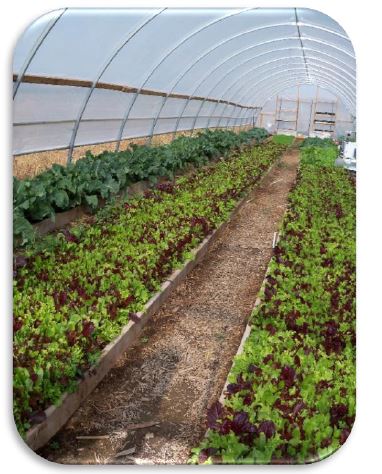
Locate a Commercial Kitchen for Food Preparation
The production of cut fruits and vegetables for sale requires processing in a commercial kitchen. A commercial kitchen is an inspected kitchen by the local health department. Before investing in a kitchen, you may want to gain experience by renting existing kitchen space or hiring a co-packer to make your product. A co-packer is a company with permitting for processing that is willing to produce your product for you. Look for a co-packer that has the capability and experience to make your product. There are very few co-packers in Nevada. If a co-packer is not available for outsourcing, consider renting a kitchen. It is recommended to rent a kitchen space rather than building your own facility to gain experience and to figure out equipment and layout needs and preferences. Larger cities may have incubator or community kitchens available for rent by the hour. Sometimes a local certified kitchen in a senior center, school facility or restaurant can be rented in smaller communities. Make sure that the kitchen is or can become approved for processing your products by discussing this with the local health inspector and building department.
Preparing Your Workspace
Commercial kitchens are subject to inspection by local health authorities and have lists outlining cleaning protocols for users to follow when utilizing the space. Be sure to follow the rules of the commercial kitchen being used in order to help maintain licensing requirements. Additionally, having a washed and sanitized workspace is integral to preventing the spread of allergens, contaminants and foodborne illness. Keep kitchen surfaces, such as countertops, utensils, cutting boards and appliances, clean by washing with a cleanser such as hot soapy water, rinsing, and sanitizing using an approved sanitizer. Unscented, 6–8.25% bleach is a common sanitizing agent and should be between 50 to 100ppm, and not 200ppm, chlorine. Add 1 tablespoon bleach per 1 gallon water. The concentration of bleach and other sanitizing solutions should be checked regularly using test strips (available from restaurant supply stores). If the test strips show chlorine levels above 100ppm, add a pint of water. The pH of the water impacts the chlorine levels, so test strips should be used to ensure proper concentrations of sanitizer are used.
Do not use smelly dishcloths, towels or sponges, as this is a sign of potential bacterial growth. Dishcloths and towels should be laundered on site often using bleach in the hot cycle of the washing machine. Follow NAC 446.371 to .377 for guidance. Utensils and cookware should be washed in hot soapy water, rinsed in clean water, and sanitized using an approved sanitizer or 171-degree Fahrenheit water. Alternately, these items can be cleaned using a commercial dishwasher. Follow NAC 446.301 to .333 for manual and mechanical guidance on dishwashing. Be sure to follow manufacturer instructions, as settings can vary.
Work surfaces and cutting boards should be cleaned when working with different ingredients (such as, working on carrots then switching to tomatoes). Always use a clean cutting board and wash, rinse and sanitize it after use. To disinfect a cutting board, a fresh solution of 1 tablespoon of unscented, liquid chlorine bleach per gallon of water may be used.
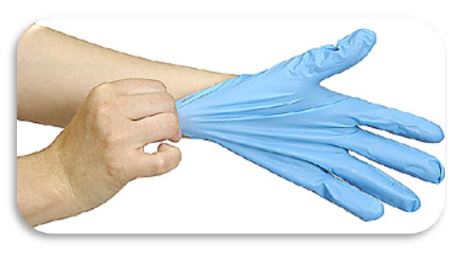
Refrigeration Equipment
Refrigeration equipment, including refrigerators or walk-in coolers, trays/liners, utensils, or any other equipment, should be clean and in proper working order. Since temperatures at or below 41 degrees Fahrenheit can prevent dangerous microbes from growing in the cut produce, the refrigeration units will have to be monitored for maintaining the cold temperature. Be sure to follow manufacturer guidelines for maintenance of refrigerators and coolers. Refrigerator temperatures should be monitored and recorded periodically during processing, but at least twice daily.
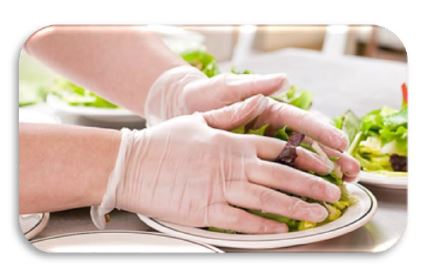
Handwashing
Gloves should be worn for food handling. Proper handwashing prevents many food contamination problems and should be taught to all involved in food handling. The following handwashing steps are useful to put into practice:
*table here
Cutting Produce
Fresh, raw produce should be cleaned with an FDA recommended biocidal wash before peeling in order to prevent dirt and bacteria from transferring from the peeler or knife onto the fruit or vegetable. A common biocidal wash can be made using unscented bleach. The wash solution should contain 50–100ppm chlorine, (about 1 tablespoon bleach per gallon of water), and have a pH between 6.0 and 7.5. Whole, uncut produce should be left in contact with this wash for one to two minutes, then rinsed in clear running water. The chlorine concentration should be checked periodically using a test strip, and a new wash solution should be made if it begins to lose its strength. It is recommended to chill washed produce to 41 degrees Fahrenheit before peeling and cutting. Once produce has been cut into pieces, it should be rinsed in cool running water. If the produce discolors after cutting, then dip it in a solution of ascorbic acid (vitamin C), lemon or lime juice to prevent color change, but be sure to add the product you use to the ingredient list.
Fresh-cut produce is considered highly perishable (and potentially hazardous). It usually carries a “Use-by” date that varies greatly from product to product. For example, cantaloupe has a very short shelf life compared to baby carrots. The FDA recommends conducting microbial testing to determine shelf life, and this should be done by a qualified lab.
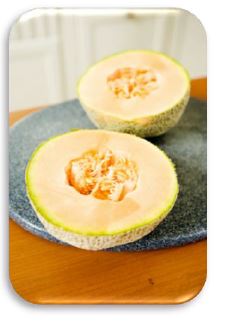
It is also recommended that environmental testing (such as surface swabs, drains and non-municipal water) be conducted on a regular basis, and that products be routinely monitored for the following bacteria:
- Listeria – important to test because it grows at refrigeration temperatures. Listeria caused the outbreak in cantaloupe several years ago that bankrupted the grower.
- Salmonella – becoming more common in fruits and vegetables in recent years. Refrigeration is a good control of Salmonella, but if food is left out for four hours or more in the dangerous temperature range (41–135 degrees Fahrenheit) it can be an issue.
- E. coli – not as prevalent but needs to be monitored.
- Any other bacteria that are known to be associated with a specific fruit or vegetable. Talk to a microbiologist, food scientist or crop specialist to identify these.
The FDA doesn’t approve, accredit or certify food testing laboratories. They do provide a list of methods that a food testing lab should use to ensure consistent procedures are being used across the country. Look for a food lab that lists one of these FDA method references as an indicator of potentially providing valid testing results.
Packaging Considerations
Packaging serves several purposes for food products. It:
- provides a barrier against dirt and debris,
- protects from damage and pests,
- prevents loss of moisture,
- allows for safer handling during transport and sale, and
- can motivate customers to purchase the product.
Packaging must be durable in order to protect food items from contamination during transport, display, sale and purchase by consumers and “should be designed to prevent physical damage to produce” (ATTRA, 2000). The desirability of the fruit or vegetable being sold can be highlighted with a professional label, which is a strong marketing tool that entices consumers to purchase the product.
Processors should consider the following when selecting packaging:
- product requirements (protection),
- design, and
- cost and availability.
Packaging should be suitable for the specific product it contains. There are several different types of packaging, including flexible (plastic bags), semi-flexible and rigid. The materials used to make the packaging vary as well (including plant fibers, paper, glass and plastics).
Only use packaging that is food grade. Packaging for candy and confection products must not be oxygen-reduced to qualify as a cottage food. Without proper procedures, reduced-oxygen packaging unknowingly can provide an environment for the growth of health-hazardous organisms. Oxygen-reduced packaging is when the oxygen levels have been reduced below normal atmospheric levels inside the package. Examples of reduced-oxygen packaging include:
- vacuum packaging,
- modified or controlled atmosphere packaging, which includes oxygen-scavenging packaging (oxygen remover packets) or adding other gases into the packaging before sealing, and
- placing hot ingredients in packaging that has low or no oxygen transmission.
Bakery boxes, plastic bags closed with a twist tie, paper bags, and clamshells are examples of packaging that may be used. If unsure whether packaging is appropriate for your product, get further information from the manufacturer.
Processors should consider the availability and pricing of packaging for their product. Avoid choosing a package design that is being discontinued or does not protect the product. If the packaging is too expensive, the margin for profit will decrease. For further packaging information, see the resource section of this document found on Page 13.
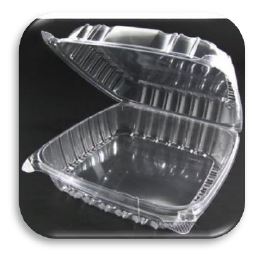
Labeling Requirements and Considerations
The State requires commercial food products to be labeled following federal guidelines that can be found at: Guidance for Industry: Food Labeling Guide. The label of your product needs to be sent in with the State registration. When creating food product labeling, it is important to keep the label as clear as possible. Approved health claims can be made on the label, but the FDA has specific rules about when and how they can be used, and the FDA expects that the labeling will be correct. To learn what is considered a health claim, review the following link on the FDA website.
A nutrition labeling exemption may be available to small businesses that do not have a nutritional or health claim. These companies may not have to file a notice or may be able to file for an exemption depending on sales of that product and number of employees. Check the FDA website for how your product applies at: Small Business Nutrition Labeling Exemption.
Labels can be made in house on specialty printers or ordered from printer companies. The choice will depend upon volume, cost and convenience. The label requires:
- name of product,
- weight/volume,
- list of ingredients,
- care of product (such as refrigerate after opening), and
- contact information leading back to the processor (such as website, physical address, etc.).
There are specifics in format and design required for labels. The Food and Drug Administration has a food-labeling guide available online that outlines federal labeling requirements: Guidance for Industry: Food Labeling Guide. To get started on designing a label, examine the lettering, size and placement of required information on labels of similar products being sold.
Remember to make a professional label, as many consumers buy based on the product’s look. Run it past others with keen judgment in the area. Ensure the product has a lot number on it. You may consider adding Quick Response (QR) and bar scan codes to service target markets. Most stores insist on them, and smartphones have apps to use the information. These codes often have fees to gain and maintain them.
Food allergen listing is critical for the safety of consumers and must be considered when creating a label for your food product. Major food allergens include:
- milk,
- eggs,
- fish,
- crustacean or bivalve shellfish,
- any ingredient that contains protein derived from any one of the above ingredients or additives
- tree nuts,
- wheat,
- peanuts, and
- soybeans.
Food allergens are a major cause of food product recalls due to contamination in an ingredient or during processing. Be mindful that products used within your product may undergo ingredient changes. Each new batch of an ingredient should be examined for changes in its ingredients, and any changes must be reflected in your product’s ingredient list. Closely follow the guidelines pertaining to food labeling. Indicate if any allergens have been processed in the facility that you are using.
Product Traceability
Knowing where ingredients come from allows food processors to know where sources of possible contamination originate if there were to be a complaint about a food product. Commercial operations are required to develop detailed documentation and records for each product produced and sold. When state and federal regulations are followed, these records detail how, where and when products were produced, as well as standard operating procedures followed at the facility (such as food handling, hygiene, etc.). Create a document that outlines the in-house handling of ingredients, including lot numbers, the date they enter the kitchen, and how they are cared for (refrigeration, etc.). See the ingredient log on the following page. Each food product created should have a detailed paper trail for all ingredients used to make the product. See the production report on the next page. A paper trail should also be created that documents the distribution of products to purchasers. If an ingredient is tainted, these details allow for the origin to be found and any purchasers to be alerted. Ensure that you create log sheets that satisfy your health department needs.

Storage, Transport and Sales
Produce should be transported and stored in containers that are disposable (cardboard) or able to be repeatedly cleaned and sanitized (produce tubs). Raw products should be stored separately from processed products:
- in different coolers,
- on different shelving units,
- on right and left sides of the refrigerator, or
- with processed foods on top and raw products on the bottom of the refrigerator.
Cut fruits and vegetables should be refrigerated at 41 degrees Fahrenheit or below. Fresh fruits should be stored separately from fresh vegetables, as some fruits give off ethylene gas and can cause vegetables to spoil. Fruits may also absorb undesirable flavors from vegetables. Never put meat, dairy, shellfish or other high-risk foods above the produce in the cooler, as cross contamination can easily occur if the high-risk foods leak onto the produce. Ideally, cut fruit will be stored in a separate cooler from all other food items.
In order to maintain safe temperatures, cut fruits and vegetables requiring refrigeration should be transported in a refrigerated unit. The process by which the produce is transported from the cooler to a mobile cooler unit to market is considered an important Control Point (CP) and should be included in the production plan. Logs of the temperature at each point in storage and transport should be kept. The cooler trailer or truck should have an automatically controlled cooling system and a temperature monitoring system to determine that the temperature has remained below 41 degrees Fahrenheit.
The space needed for storage of dry ingredients and for refrigeration is often underestimated in startup companies. Calculate the amount of space needed for the incoming ingredients and outgoing product during peak production periods and be sure to have space available.
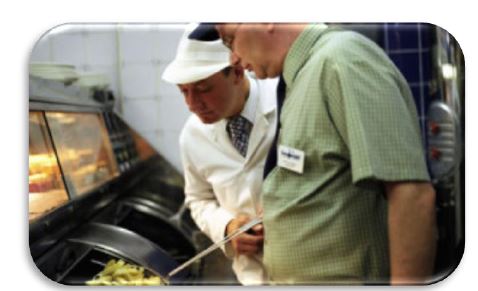
*tables here
Registration of Food Product with State
After recipes and safe processing procedures have been developed and required product labels have been created, it is time to submit everything to the State. Differing procedures will correspond with the differing food products and their food-safety situation. All label reviews, regardless of the product, cost $83. After receiving your application, the health department will send back a formal response indicating the areas that need to be addressed to gain approval. Discuss the changes needed with the health department and reply. Contact the health department at any time for further clarity.
Business
Often new business owners become so passionate about their product that the needed business activities of marketing, distribution, accounting and paperwork get neglected. Take time to set up simple systems and ensure that someone has designated time to address these tasks. Help in developing the business can be found with a local business counselor or online at: U.S. Small Business Administration.
Marketing and distribution are essential to the business because customers must know about your product and have access to it before sales can occur. The business plan, budgeting and accounting become essential to determine where the business is successful or where it needs improvement to survive. The city, county and state licenses; state and federal registrations; and insurance required for the business must be continued and considered as part of the budget. Without all of these key tasks occurring, a business will fail.
Resources
References
- Ettenson, R., Conrado, E., and Knowles, J., 2013, Rethinking the 4 P's, Harvard Business Review.
- Food and Drug Administration, 2013, Food Labeling Guide, Guidance for Industry: Food Labeling Guide.
- Food and Drug Administration, 2008, Guidance for Industry: Guide to Minimize Microbial Food Safety Hazards of Fresh-cut Fruits and Vegetables, Guidance for Industry: Guide to Minimize Microbial Food Safety Hazards of Fresh-cut Fruits and Vegetables.
- Gatzke, H., 2012, Developing a Local Food Industry in Nevada. University of Nevada Cooperative Extension, Special Publication-12-05.
- Nevada Administrative Code (NAC): CHAPTER 446 - FOOD ESTABLISHMENTS.
- Nevada Secretary of State, State Business License – FAQ.
- Small Business Administration.
- State of Nevada’s Health and Human Services, ENVIRONMENTAL HEALTH.
- University of Maryland, 2014, Marketing 101.


